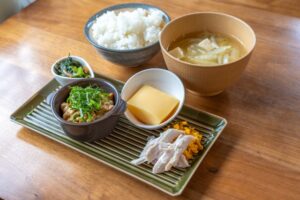Discover the Beauty of Washoku: Traditional Japanese Cuisine

Washoku (和食), or traditional Japanese cuisine, is more than just food—it is an art form that embodies Japan’s cultural heritage, seasonal awareness, and commitment to harmony. Recognized as a UNESCO Intangible Cultural Heritage, Washoku has captivated the world with its delicate flavors, aesthetic presentation, and emphasis on health. Let’s dive into the essence of Washoku and why it continues to charm people globally.
What is Washoku?

The term “Washoku” translates to “Japanese food” but carries a much deeper meaning. Rooted in the principles of harmony (和) and respect for nature, Washoku reflects the Japanese way of life. At its core, Washoku consists of four key elements:
- Seasonality: Seasonal ingredients are central to Washoku. Whether it’s cherry blossoms in spring or matsutake mushrooms in autumn, dishes are designed to celebrate the natural bounty of each season.
- Balance: Washoku is structured around the principle of ichiju-sansai—”one soup, three dishes”—ensuring nutritional balance and variety.
- Aesthetic Presentation: Every dish is carefully arranged, reflecting the importance of visual appeal and harmony with the seasons.
- Connection to Nature: Ingredients are minimally processed to preserve their natural flavors, emphasizing a connection to the land and sea.
A Taste of History

The roots of Washoku date back to ancient Japan, where meals were influenced by religious practices such as Shinto and Buddhism. These traditions emphasized simplicity and reverence for the ingredients. During the Heian period (794–1185), court cuisine developed, showcasing elegant preparations that still influence Washoku today.
The Edo period (1603–1868) marked a turning point, as regional ingredients and cooking techniques began to flourish. Sushi, tempura, and other iconic dishes emerged, solidifying Japan’s culinary identity. Over time, Washoku has adapted while preserving its fundamental values of harmony and respect.
Iconic Washoku Dishes

- Sushi: A globally recognized symbol of Japanese cuisine, sushi combines vinegared rice with fresh fish or vegetables, showcasing simplicity and balance.
- Miso Soup: A comforting soup made with fermented soybean paste, miso soup is a staple in Japanese meals, offering both flavor and nutritional benefits.
- Tempura: Lightly battered and fried seafood or vegetables, tempura highlights the art of precision cooking.
- Soba and Udon: These traditional noodles, made from buckwheat or wheat flour, are served in a variety of ways to suit the seasons.
- Kaiseki: A multi-course meal that epitomizes the artistry of Washoku, Kaiseki celebrates seasonal ingredients through meticulous preparation and presentation.
Why Washoku is Loved Worldwide
- Health Benefits: Washoku’s reliance on fresh, minimally processed ingredients contributes to its reputation as a healthy cuisine. Dishes are often low in fat and high in nutrients, promoting longevity and wellness.
- Cultural Connection: Each dish tells a story, offering insight into Japan’s history, geography, and traditions.
- Versatility: From quick street foods to elaborate Kaiseki meals, Washoku caters to diverse tastes and occasions.
- Sustainability: Washoku emphasizes respect for nature and waste reduction, aligning with modern values of sustainability.
Experience Washoku Yourself
Whether you’re visiting Japan or exploring its cuisine from afar, Washoku offers endless opportunities to engage with its flavors and traditions. Consider trying a cooking class to learn the art of sushi-making, or visit a local market to sample seasonal specialties. Through Washoku, you can savor not just the taste of Japan but also its spirit of harmony and respect for nature.
Let Washoku transport you to a world of tradition, flavor, and beauty!
